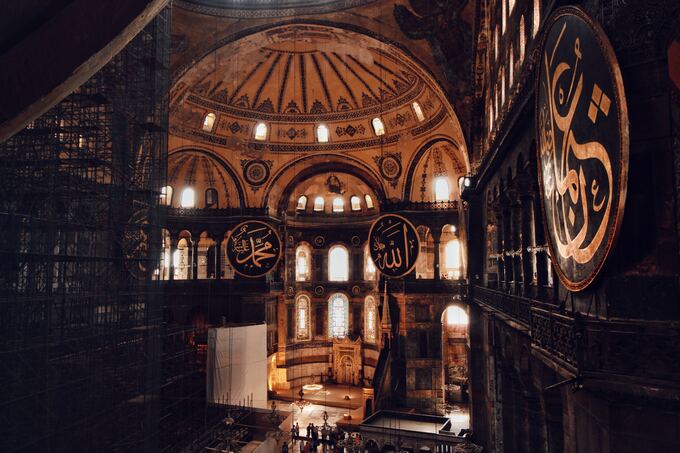The Ottoman Empire, founded in 1299 by Osman I, was a vast and influential empire that spanned several continents and centuries. Let’s delve into an introduction to the Ottoman Empire and explore its key features.
Introduction to the Ottoman Empire
The Ottoman Empire emerged under the leadership of Osman I, a tribal leader in Anatolia, in the late 13th century. Over time, it grew to become a dominant force in the Mediterranean and the Middle East, expanding its territories through conquest and strategic alliances (Khan Academy). The empire reached its peak in the 16th century under the rule of Suleiman the Magnificent, controlling vast territories in Europe, Asia, and Africa (Source).
Key Features of the Ottoman Empire
The Ottoman Empire was characterized by several key features that contributed to its prominence and longevity. These features include:
- Highly Centralized Government: The empire had a centralized government with the sultan as the supreme ruler. The sultan governed through a complex bureaucracy and a system of local provinces known as eyalets (Khan Academy). This centralized structure enabled effective governance and administration of diverse territories and peoples.
- Strong Military: The Ottoman Empire had a powerful military, which played a crucial role in its expansion and defense. The empire’s military prowess was renowned, and it controlled key trade routes, contributing to its wealth and prosperity (Khan Academy).
- Cultural and Intellectual Achievements: The Ottoman Empire had a rich cultural heritage, exhibiting a blend of various influences such as Byzantine, Persian, and Arab. It was known for its vibrant art, architecture, and literature. The empire fostered a thriving intellectual and artistic environment, contributing to advancements in fields such as calligraphy, music, and poetry (ottoman empire art).
- Religious Tolerance: The empire embraced religious diversity and implemented a system known as the millet system. This system allowed different religious communities, such as Muslims, Christians, and Jews, to maintain their own laws and customs under the empire’s overall governance. While the empire was predominantly Muslim, it accommodated various religious groups, fostering a sense of religious coexistence (ottoman empire religion).
The Ottoman Empire’s historical significance and enduring influence can still be observed today. From its impact on modern Turkey to its influence on the Middle East and the world, the empire’s legacy is deeply ingrained in the fabric of history (ottoman empire timeline).
Rise and Expansion of the Ottoman Empire
The rise and expansion of the Ottoman Empire marked a significant period in history. From its humble beginnings to its golden age, the empire’s growth and conquests played a crucial role in shaping its history. Let us delve into the founding, expansion, and the golden age under Suleiman the Magnificent.
Founding of the Ottoman Empire
The Ottoman Empire was founded in the early 14th century by Osman I, a charismatic leader who established a small principality in Anatolia. The empire derived its name from Osman, and under his leadership, it gradually expanded its influence and territory. Osman’s successors, known as the sultans, continued to build upon his legacy and expand the empire’s reach.
Expansion and Conquests
As the Ottoman Empire grew, it expanded its territories through a series of conquests. The empire’s military prowess enabled it to conquer strategic regions and establish dominance over key trade routes. The Ottoman armies successfully captured Constantinople in 1453, marking a significant milestone in their expansion and transforming the city into Istanbul, the empire’s new capital.
Over the centuries, the empire continued to expand its borders, encompassing vast territories that stretched across three continents: Europe, Asia, and Africa. The empire’s military campaigns and conquests brought diverse regions and populations under its rule, solidifying its position as a major power in the Mediterranean.
The Golden Age under Suleiman the Magnificent
The Ottoman Empire reached its zenith during the reign of Suleiman the Magnificent, who ascended to the throne in 1520. Suleiman’s rule is often referred to as the empire’s golden age. Under his leadership, the Ottoman Empire experienced significant cultural, intellectual, and architectural achievements.
Suleiman’s military campaigns expanded the empire’s territories to their widest extent. The empire reached its peak during his reign, encompassing regions from Hungary to the Persian Gulf. Suleiman’s armies conquered key cities such as Belgrade, Rhodes, and Baghdad, further establishing Ottoman dominance.
In addition to military conquests, Suleiman fostered a flourishing cultural and intellectual environment. The empire witnessed an artistic and architectural renaissance, with grand structures like the Süleymaniye Mosque and the Topkapi Palace being built during this period. The empire also became a center for learning and scholarship, attracting scholars and intellectuals from around the world.
The rise and expansion of the Ottoman Empire laid the foundation for its future governance, society, and challenges. To explore further aspects of this historical empire, continue reading about its governance and society in the next section.
Governance and Society in the Ottoman Empire
During its vast and influential existence, the Ottoman Empire had a well-structured system of governance and a diverse society. This section explores the political structure and administration of the empire, the social structure with a focus on the millet system, and the remarkable cultural and intellectual achievements that emerged within the empire.
Political Structure and Administration
The Ottoman Empire operated under a centralized government, with the sultan serving as the supreme ruler (Khan Academy). The sultan governed through a complex bureaucracy and a system of local provinces known as eyalets. The empire’s administrative structure was designed to ensure effective governance and maintain control over its vast territories.
The sultan appointed high-ranking officials, such as viziers and pashas, who were responsible for overseeing various aspects of governance, including finance, justice, and military affairs. These officials formed the imperial council, known as the Divan, which advised the sultan on important matters of state.
Social Structure and Millet System
The Ottoman Empire embraced a diverse population, consisting of Muslims, Christians, Jews, and other religious and ethnic minorities. To manage this diversity, the empire practiced a system of governance known as the millet system (Britannica). Under this system, religious and ethnic communities were granted a certain degree of autonomy in their internal affairs.
Each community, known as a millet, was led by its own religious or ethnic leader who had the authority to govern and make decisions on matters such as education, religious practices, and family law. This system allowed for a level of self-governance and protected the rights and privileges of various religious groups within the empire (Khan Academy).
Cultural and Intellectual Achievements
The Ottoman Empire left a significant cultural and intellectual legacy. Istanbul and other major cities within the empire became renowned centers of artistic and intellectual activity, particularly during the reign of Suleiman the Magnificent. The empire excelled in various artistic fields, including calligraphy, painting, poetry, textiles and carpet weaving, ceramics, and music. Ottoman artistry and craftsmanship were highly valued, and their influence extended beyond the empire’s borders.
In addition to artistic achievements, the Ottomans made remarkable advancements in the fields of science, medicine, and philosophy. Scholars during this era contributed to the fields of mathematics, astronomy, philosophy, physics, geography, and chemistry. The empire also played a significant role in the development of medicine, with Ottoman surgeons inventing surgical instruments that are still used today (History.com).
The governance and society of the Ottoman Empire were characterized by a well-structured political system, a diverse population, and a flourishing cultural and intellectual environment. These aspects shaped the empire’s history and left a lasting impact on the regions it once encompassed. To learn more about the fascinating history of the Ottoman Empire, continue reading about its challenges and decline in the next section.
Challenges and Decline of the Ottoman Empire
As the Ottoman Empire entered the late 17th century, it faced a series of challenges that contributed to its decline and eventual dissolution after World War I in 1922. These challenges can be categorized into internal conflicts and power struggles, military defeats and territorial losses, and economic challenges and financial instability.
Internal Conflicts and Power Struggles
Internal conflicts and power struggles plagued the Ottoman Empire during its decline. Competing factions within the ruling elite vied for control, leading to political instability and weakening the empire’s central authority. Power struggles among the sultans, viziers, and influential families further exacerbated the internal divisions, hindering effective governance and decision-making (Britannica).
Military Defeats and Territorial Losses
The Ottoman Empire suffered a series of military defeats and territorial losses that significantly weakened its position. The empire faced military setbacks against European powers, resulting in the loss of key territories. Greece gained its independence in 1830, and Romania, Serbia, and Bulgaria became independent in 1878 (Britannica). The empire also experienced territorial losses during the Balkan Wars in 1912 and 1913, further diminishing its control over its territories (History.com).
Economic Challenges and Financial Instability
The Ottoman Empire faced significant economic challenges and financial instability during its decline. The empire struggled with inflation, increasing debt, and a weakening economy. Economic decline and financial mismanagement undermined the empire’s ability to fund its military, maintain infrastructure, and address the needs of its diverse population. These economic challenges further weakened the empire and hindered its capacity to respond effectively to external pressures (Britannica).
The challenges faced by the Ottoman Empire during its decline were multifaceted and interconnected. Internal conflicts and power struggles weakened the empire’s ability to defend itself against external threats and navigate the changing geopolitical landscape. Military defeats and territorial losses eroded the empire’s control over its territories, while economic challenges and financial instability further undermined its strength. These factors collectively contributed to the decline and eventual dissolution of the Ottoman Empire.
To explore more about the rise and fall of the Ottoman Empire, you can refer to our articles on ottoman empire religion, ottoman empire art, ottoman empire timeline, and ottoman empire military.
The End of the Ottoman Empire
As the 20th century dawned, the Ottoman Empire was faced with numerous challenges that ultimately led to its dissolution. The empire’s decline began in the late 17th century and continued until its official end in 1922 after World War I. This section will explore the events that marked the end of the Ottoman Empire, including World War I and the establishment of the Republic of Turkey.
World War I and the Dissolution of the Empire
World War I played a significant role in the unraveling of the Ottoman Empire. Initially, the empire joined the war on the side of the Central Powers, consisting of Germany and Austria-Hungary. However, the empire faced military defeats, territorial losses, and internal strife during the war, which further weakened its position (Britannica). The empire’s territories were divided among the victorious Allied powers, including British, French, Greek, and Russian control (History.com).
The empire’s involvement in World War I strained its resources and exacerbated existing internal conflicts. The empire’s diverse population, comprising numerous ethnic and religious groups, also presented challenges when it came to maintaining unity. The empire’s grip on its territories weakened, and nationalist movements began to emerge, calling for independence and self-determination.
Establishment of the Republic of Turkey
The final blow to the Ottoman Empire came with the establishment of the Republic of Turkey. In the aftermath of World War I, Mustafa Kemal Atatürk, a military officer and nationalist leader, emerged as a prominent figure in the resistance against foreign occupation. Atatürk led the Turkish War of Independence, successfully repelling foreign forces and liberating Turkish territories.
In 1922, the Ottoman Sultanate was abolished, marking the official end of the Ottoman Empire. Mustafa Kemal Atatürk then established the Republic of Turkey, which sought to modernize and secularize the country (Britannica). Atatürk implemented significant reforms, including the adoption of a new legal system, the Latin alphabet, and women’s suffrage. These reforms aimed to transform Turkey into a modern nation-state.
The legacy of the Ottoman Empire lives on in modern-day Turkey. The Republic of Turkey, established after the empire’s end, emerged as a secular, democratic state under Atatürk’s leadership. The empire’s history continues to shape the country’s culture, politics, and identity, while also impacting the Middle East and the wider world (Britannica). Understanding the historical significance of the Ottoman Empire is crucial for comprehending the region’s complex dynamics and the struggles faced during its rise and fall.
Legacy of the Ottoman Empire
The Ottoman Empire, with its rich and complex history, left a lasting legacy that continues to shape the modern world. From its influence on modern Turkey to its impact on the Middle East and beyond, the empire’s historical significance cannot be overstated.
Influence on Modern Turkey
The Ottoman Empire had a profound influence on modern Turkey, shaping its political, cultural, and social landscape. Many aspects of Turkey’s legal system, administrative structure, and architectural heritage can be traced back to the empire’s legacy (Britannica). The empire’s centralized governance and administrative practices served as a model for Turkey’s modern political system. The bureaucracy and provincial divisions established during the empire’s reign laid the foundation for the country’s modern government (Khan Academy).
Impact on the Middle East and the World
The impact of the Ottoman Empire extended far beyond the borders of modern-day Turkey. It played a pivotal role in shaping the political dynamics of the Middle East and influenced the cultural and religious identity of the region. The empire’s presence influenced Islamic culture, leaving a lasting mark on art, architecture, and cuisine in various countries (Britannica). The empire’s architectural achievements, such as the iconic Hagia Sophia and the majestic Topkapi Palace, continue to inspire awe and admiration.
The decline of the Ottoman Empire also had significant geopolitical consequences in the Middle East during the 20th century. The dissolution of the empire and the subsequent redrawing of borders contributed to the emergence of modern nation-states in the region, shaping its current political landscape (Britannica).
Historical Significance of the Ottoman Empire
The Ottoman Empire holds great historical significance as one of the longest-lasting and most powerful empires in world history. Its existence spanned over six centuries, and its impact on Europe, Asia, and Africa cannot be overstated. The empire’s rise and fall shaped the geopolitical landscape and influenced the course of history. Its decline marked the end of an era and paved the way for the emergence of modern nation-states in the Middle East (History.com).
The Ottoman Empire’s enduring legacy is a testament to its cultural, political, and military achievements. Its influence on modern Turkey, its impact on the Middle East and the world, and its historical significance make it a subject of continued fascination and study. Understanding the empire’s legacy provides valuable insights into the complexities of history and the interconnectedness of global civilizations.








